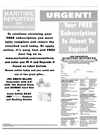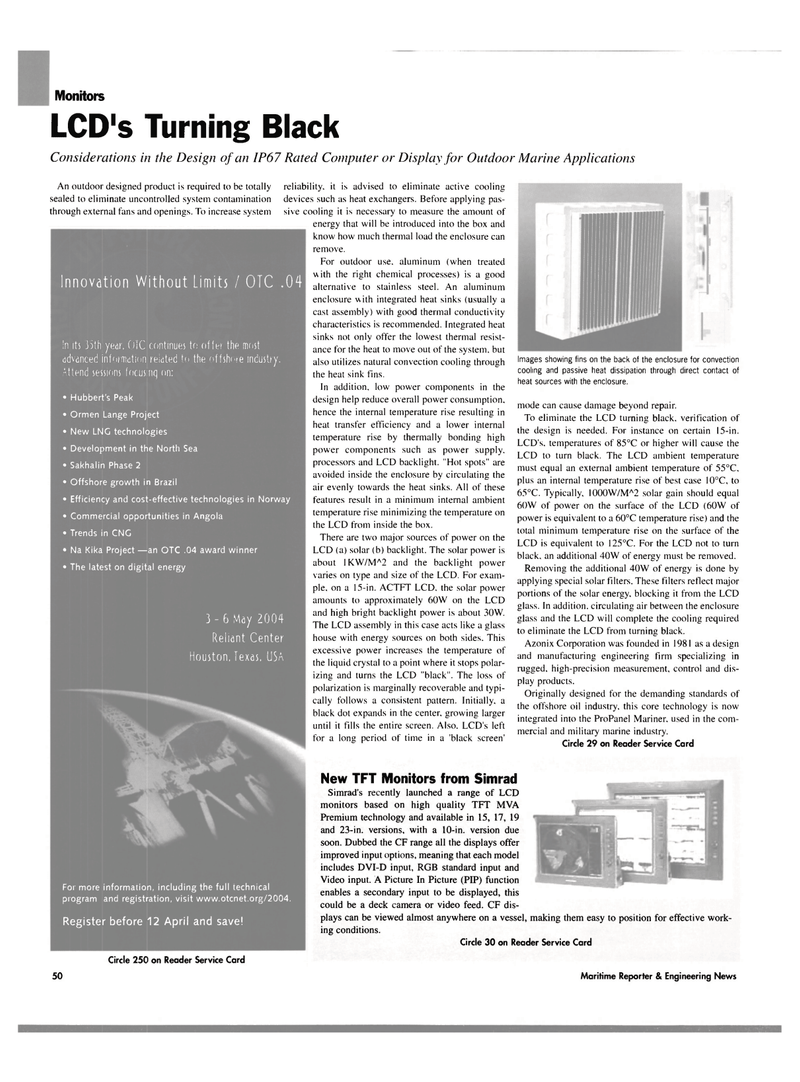
Page 55: of Maritime Reporter Magazine (February 2004)
The Tanker Yearbook: ATB Edition
Read this page in Pdf, Flash or Html5 edition of February 2004 Maritime Reporter Magazine
Monitors
LCD's Turning Black
Considerations in the Design of an IP67 Rated Computer or Display for Outdoor Marine Applications
An outdoor designed product is required to be totally sealed to eliminate uncontrolled system contamination through external fans and openings. To increase system
Innovation Without Limits I OTC .04
In its 35th year, OTC continues to offer the most advanced information related to the offshore industry.
Attend sessions focus nq on: • Hubbert's Peak • Ormen Lange Project • New LNG technologies • Development in the North Sea • Sakhalin Phase 2 • Offshore growth in Brazil • Efficiency and cost-effective technologies in Norway • Commercial opportunities in Angola • Trends in CNC • Na Kika Project —an OTC .04 award winner • The latest on digital energy 3 - 6 May 2004
Reliant Center
Houston, Texas, USA
For more information, including the full technical program and registration, visit www.otcnet.org/2004.
Register before 12 April and save!
New TFT Monitors from Simrad
Simrad's recently launched a range of LCD monitors based on high quality TFT MVA
Premium technology and available in 15, 17, 19 and 23-in. versions, with a 10-in. version due soon. Dubbed the CF range all the displays offer improved input options, meaning that each model includes DVI-D input, RGB standard input and
Video input. A Picture In Picture (PIP) function enables a secondary input to be displayed, this could be a deck camera or video feed. CF dis- plays can be viewed almost anywhere on a vessel, making them easy to position for effective work- ing conditions.
Circle 30 on Reader Service Card reliability, it is advised to eliminate active cooling devices such as heat exchangers. Before applying pas- sive cooling it is necessary to measure the amount of energy that will be introduced into the box and know how much thermal load the enclosure can remove.
For outdoor use. aluminum (when treated with the right chemical processes) is a good alternative to stainless steel. An aluminum enclosure with integrated heat sinks (usually a cast assembly) with good thermal conductivity characteristics is recommended. Integrated heat sinks not only offer the lowest thermal resist- ance for the heat to move out of the system, but also utilizes natural convection cooling through the heat sink fins.
In addition, low power components in the design help reduce overall power consumption, hence the internal temperature rise resulting in heat transfer efficiency and a lower internal temperature rise by thermally bonding high power components such as power supply, processors and LCD backlight. "Hot spots" are avoided inside the enclosure by circulating the air evenly towards the heat sinks. All of these features result in a minimum internal ambient temperature rise minimizing the temperature on the LCD from inside the box.
There are two major sources of power on the
LCD (a) solar (b) backlight. The solar power is about 1KW/MA2 and the backlight power varies on type and size of the LCD. For exam- ple. on a 15-in. ACTFT LCD. the solar power amounts to approximately 60W on the LCD and high bright backlight power is about 30W.
The LCD assembly in this case acts like a glass house with energy sources on both sides. This excessive power increases the temperature of the liquid crystal to a point where it stops polar- izing and turns the LCD "black". The loss of polarization is marginally recoverable and typi- cally follows a consistent pattern. Initially, a black dot expands in the center, growing larger until it fills the entire screen. Also. LCD's left for a long period of time in a 'black screen' mode can cause damage beyond repair.
To eliminate the LCD turning black, verification of the design is needed. For instance on certain 15-in.
LCD's, temperatures of 85°C or higher will cause the
LCD to turn black. The LCD ambient temperature must equal an external ambient temperature of 55°C, plus an internal temperature rise of best case 10°C, to 65°C. Typically, 1000W/MA2 solar gain should equal 60W of power on the surface of the LCD (60W of power is equivalent to a 60°C temperature rise) and the total minimum temperature rise on the surface of the
LCD is equivalent to 125°C. For the LCD not to turn black, an additional 40W of energy must be removed.
Removing the additional 40W of energy is done by applying special solar filters. These filters reflect major portions of the solar energy, blocking it from the LCD glass. In addition, circulating air between the enclosure glass and the LCD will complete the cooling required to eliminate the LCD from turning black.
Azonix Corporation was founded in 1981 as a design and manufacturing engineering firm specializing in rugged, high-precision measurement, control and dis- play products.
Originally designed for the demanding standards of the offshore oil industry, this core technology is now integrated into the ProPanel Mariner, used in the com- mercial and military marine industry.
Circle 29 on Reader Service Card
Images showing fins on the back of the enclosure for convection cooling and passive heat dissipation through direct contact of heat sources with the enclosure.
Circle 250 on Reader Service Card 50 Maritime Reporter & Engineering News

 54
54

 56
56
